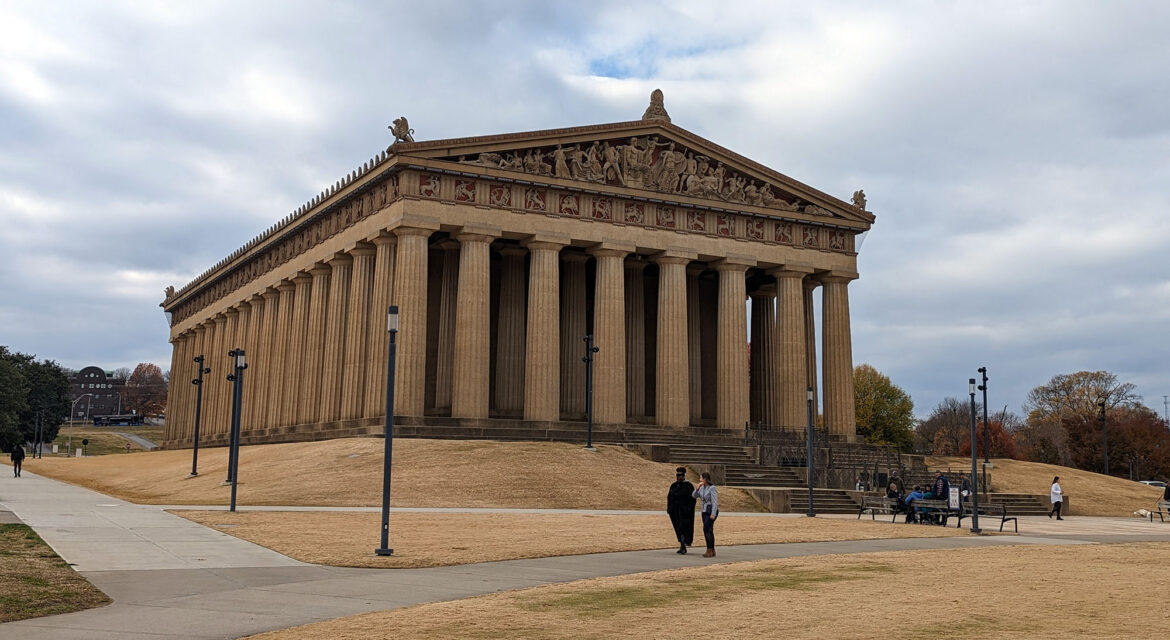 Built as the centerpiece of the Tennessee Centennial Exposition of 1897, the Nashville Parthenon is a full-scale replica of the famous temple in Athens, Greece. Located in the heart of Nashville, Tennessee, what was originally intended to be a temporary structure became a permanent one thanks to the popularity of the concept, highlighting what it can mean to honor a civilizational legacy while also allowing audiences to experience a connection with the hearts and minds of people from entirely different eras.
Built as the centerpiece of the Tennessee Centennial Exposition of 1897, the Nashville Parthenon is a full-scale replica of the famous temple in Athens, Greece. Located in the heart of Nashville, Tennessee, what was originally intended to be a temporary structure became a permanent one thanks to the popularity of the concept, highlighting what it can mean to honor a civilizational legacy while also allowing audiences to experience a connection with the hearts and minds of people from entirely different eras.

From Temporary Connection to Permanent Landmark
 Tennessee’s 1897 Centennial Exposition marked the one-hundredth anniversary of statehood. Commemorating the past hundred years of Tennessee’s achievements and history, the event featured various buildings, fairs and theme days. The recreated Parthenon was the centerpiece of the Expo, partly because the city had been colloquially known as the “Athens of the South” due to a focus on higher education.
Tennessee’s 1897 Centennial Exposition marked the one-hundredth anniversary of statehood. Commemorating the past hundred years of Tennessee’s achievements and history, the event featured various buildings, fairs and theme days. The recreated Parthenon was the centerpiece of the Expo, partly because the city had been colloquially known as the “Athens of the South” due to a focus on higher education.
The popularity of the Nashville Parthenon enabled it to outlast the Expo, but the brick, wood and plaster that it was constructed of meant that the structure quickly eroded. After being torn down in 1920, the decision was made to re-create the Parthenon using permanent materials. It was decided to make the new structure as a compete replica as possible, recreating the camber of the horizontal lines, the inclination of columns and walls and the entasis of the columns.
By 1925, the exterior of the newly reconstructed Parthenon was complete. Plaster replicas of the Parthenon Marbles are direct casts of the original sculptures, which adorned the pediments of the Athenian Parthenon. In 1982, Alan LeQuire was commissioned to re-create the Athena Parthenos statue in Nashville. The piece was unveiled in 1990. This setup and structure allow audiences to experience a space, mindset and multiple cultures that span eras and civilizations.

Community and Revenue Connections
 Since the 1930s, the Parthenon has posted changing art exhibitions in its galleries. These galleries feature art and history that is designed to educate both Nashvillians and visitors about the legacy of the ancient Greeks and their impact on American civilization. Audiences can also take in the space of the recreated temple to better understand the impact of the original building on architectural history.
Since the 1930s, the Parthenon has posted changing art exhibitions in its galleries. These galleries feature art and history that is designed to educate both Nashvillians and visitors about the legacy of the ancient Greeks and their impact on American civilization. Audiences can also take in the space of the recreated temple to better understand the impact of the original building on architectural history.
The engage that the Nashville Parthenon has cultivated in the community can be seen in multiple places. In the summer, local theater productions use the building as a backdrop for classic Greek plays. Kidsville at the Parthenon further underscores a commitment to experiences for visitors of all types.
The Parthenon also has numerous sources of direct revenue, with admission that can be purchased on-site at the Ticket Counter or in the Museum Store. Centennial Park and Parthenon Merchandise is available for purchase, featuring products that incorporate the Parthenon, Musicians Corner, Nashville Earth Day t-shirts and more.
Centennial Park Conservancy membership can be purchased online in advance. With room for up to 225 seated guests or 500 for a less formal event, the building also has the space to host weddings or corporate parties. All of these opportunities highlight the powerful community and economic impact that have come from a recreation of what many consider to be one of the high points of classical Greek art that greatly impacted Western civilization.

A Legacy of Experiences and Civilization
 As the world’s only exact-size and detailed replica of the original temple in Athens, the Nashville Parthenon is the only place audiences can experience the masterpiece of Greek classical architecture in such a personal manner. That they can do so while also taking in the culture and connections of the modern community highlights the incredible impact such monuments can enable.
As the world’s only exact-size and detailed replica of the original temple in Athens, the Nashville Parthenon is the only place audiences can experience the masterpiece of Greek classical architecture in such a personal manner. That they can do so while also taking in the culture and connections of the modern community highlights the incredible impact such monuments can enable.

